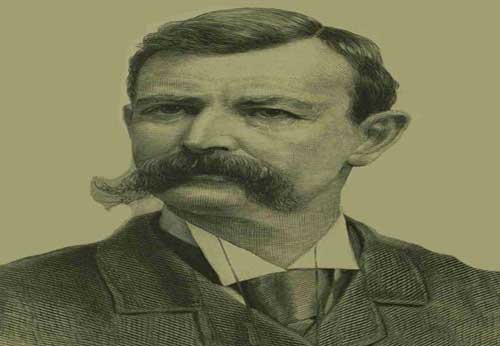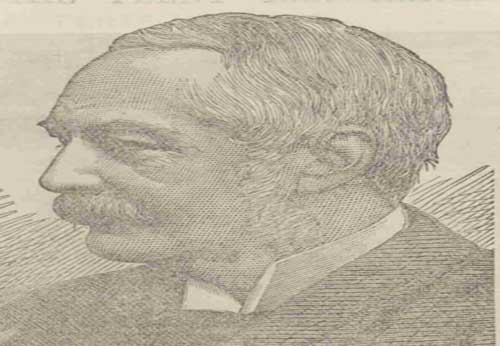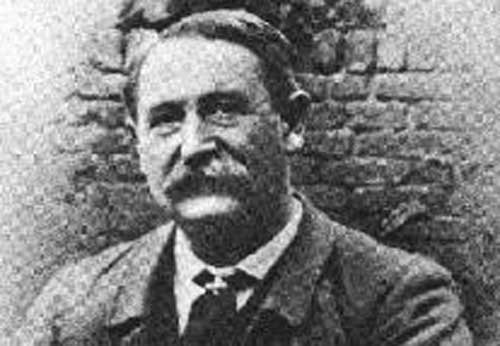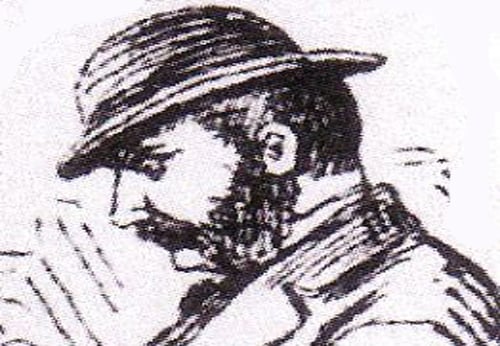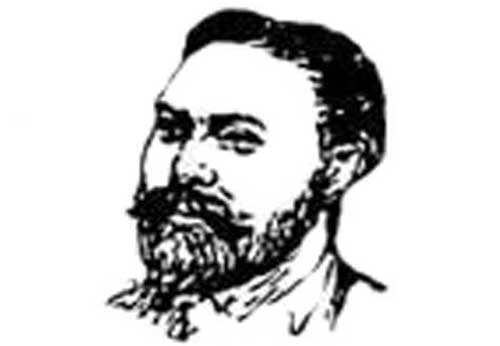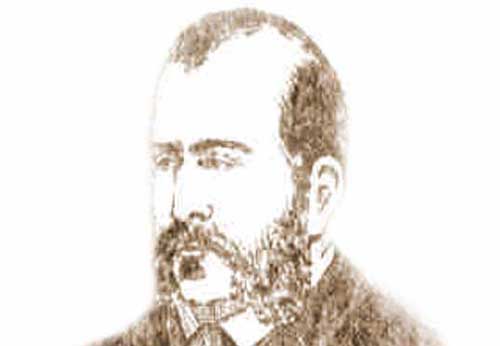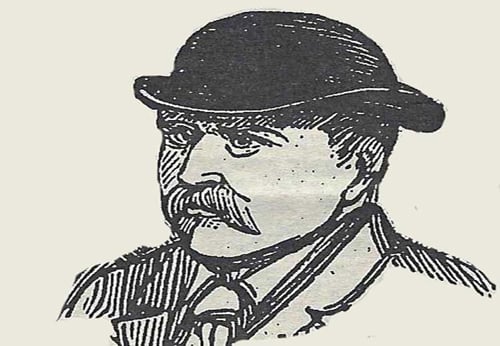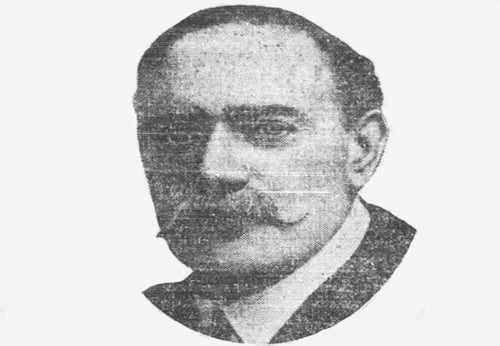- Inspector Edmund Reid was the head of H Division's Criminal Investigation Department throughout the Whitechapel murders.
- He was sent to Bethnal Green in 1885, and, in 1886, he set up the Metropolitan Police's J Division.
- He served most of his police career in the East End of London.
- He retired from the Metropolitan Police in 1896.
- Site Author and Publisher Richard Jones
- Richard Jones
INSPECTOR EDMUND REID
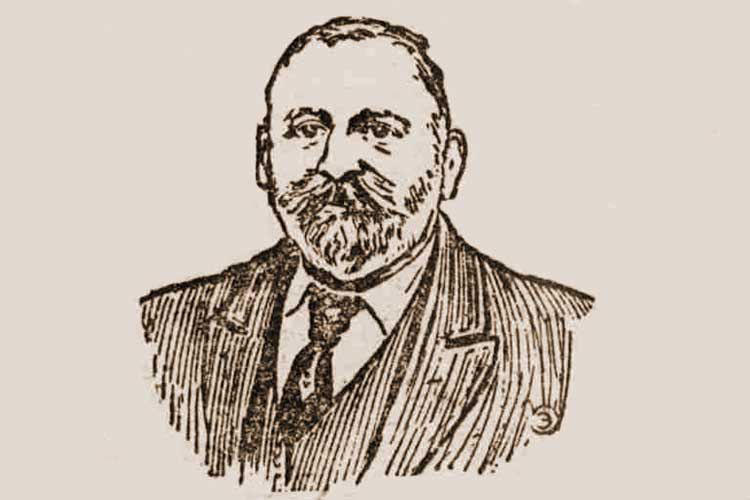
HEAD OF THE H-DIVISION DETECTIVES
Inspector Edmund Reid (1846 - 1929) was the detective who had charge of the Criminal Investigation Department (CID) of the Metropolitan Police's H Division during the Jack the Ripper and Whitechapel murders.
He was described by the Weekly Despatch, on August 3rd, 1896 as, "one of the most remarkable men of the century", an endorsement he would make extensive use when, having retired from the Metropolitan Police, he set up in business as a private detective.
In fact, Edmund Reid seems to have impressed just about everybody he came into contact with (criminals excepted!) and at the height of the Whitechapel Murders, when press criticism against the police was mounting and merciless, the satirical magazine Toby opined that "were it not for a little individuality displayed by some officers, few criminals would be brought to justice."
The article was accompanied by a cartoon depicting "a clever East End detective Inspector Reid" who was shown astride a donkey which was intended to represent Scotland Yard.
A DISTINGUISHED CAREER
After his retirement from the police, in 1896, the following laudatory article about him appeared in The Canterbury Journal and Farmers' Gazette, on Saturday, 2nd May, 1896:-
Detective Inspector Edmund James Reid, who for over twenty years has been one of the cleverest members of the London detective force, and was for a long period on the Staff at Scotland Yard, has just retired on pension, and is being honoured in London with a testimonial from the public.
Mr. Reid was born in Canterbury on the 21st. March, 1846, over Pickford's office in Beer Cart lane, his father being Pickford's agent at the time.
He was married to Miss Emily Wilson, Canterbury, at the Peculiar Baptist Chapel in New-road on the 5th July, 1867, and the wedded life of the pair has been an exceedingly happy one.
Mrs. Reid's father, Mr. John Wilson, who died eighteen months' ago was employed at Canterbury Cathedral for 50 years and saw four archbishops in office.
Mr. Reid is one of those self lifted of whom Canterbury has reason to be proud.
In his youth he tried several occupations and had a more or less chequered career.
Eventually, shortly after he reached man's estate, he joined the Metropolitan police force and rapidly earned promotion, thanks to an industrial disposition and an indomitable courage.
His nervous system was of the kind peculiar to Blondin.
As a balloonist he was one of the most daring and he was the first man to perform the parachute feat, some years later to be associated with the name of Professor Baldwin. Reid holds gold and bronze medals from the Balloon Association of Great Britain for making the highest accents on record in a balloon.
This innate courage enabled him as a detective to make some remarkable arrests, and he holds twenty-five awards from the Chief Commissioner of the Police for the courageous capture of desperate criminals.
The retirement of Reid from the force has created quite a stir in the East End of London, where he came to be regarded quite as the people's chief protector during the great scare of the "Ripper" murders.
Throughout that time, and until a few weeks back, he was in charge of the detective department in which Whitechapel is included.
Edmund Reid is a finely-built, powerful man and looks to have quite a quarter of a century of life of retirement before him."
REID'S EARLY POLICE CAREER
Reid Joined the Metropolitan Police on 4th November, 1872, and was given Warrant number 56100.
Looking back on his life with the Metropolitan Police in his retirement, Edmund Reid had this to say about his early years with the force, in an interview that he gave to Lloyd's Weekly Newspaper, on 4th February, 1912:-
I first joined the police at Carter-street, Walworth, and became 478 P.
At that time I was the shortest man in the force; in fact, the standard was lowered to 5ft. 6 1/2in. for a fortnight because they wanted men badly, and I could not even reach that.
But coming fresh from the boats I was healthy and strong, and the chief inspector, who was in charge, said it did not matter.
I had eighteen months' uniform duty, including the regulation of the traffic at the Elephant and Castle.
I was appointed detective constable in the old detective branch that was succeeded by the C.I.D. in July, 1878.
There I stayed for three or four years, always making it a point to dress smartly..."
SOME OF HIS EARLY ARRESTS
By 1877, he had joined the Detective Department of P Division, and was busily ridding the streets of the Victorian metropolis of as many of its criminal elements as he could lay his hands on, and was being commended for his exemplary record by magistrates he brought his arrestees before.
Elizabeth Roberts and Annie Tracey were just two of London's criminal classes who found themselves apprehended by the eager young officer.
The Morning Post, reported on their arrest, and on Reid's subsequent court appearance against them, in its edition of Saturday, October 20th, 1877.
Elizabeth Roberts, 28, married, and Annie Tracey, 24, married, were indicted for feloniously stealing a quantity of serge, the property of Thomas Vicary.
It appeared from the evidence that upon the evening of October 5 Detective-officer Edmund Reid, of the P Division, and Constable Walsh, 15 M, saw the prisoners near the Elephant and Castle, Roberts at the time carrying a large bundle.
On being questioned the prisoners ran away, but were captured, and the bundle proved to be serge stolen from a shop in Bermondsey.
The jury found the prisoners guilty.
Several convictions, including one of penal servitude for seven years, were proved against Roberts, and one conviction against Tracey.
Mr. Harrison sentenced Roberts to 10 years' penal servitude and seven years' police supervision; and Tracey to 12 months' imprisonment with hard labour and five years' police supervision.
He also observed that the conduct of the officers, Reid and Walsh, engaged in the case had been exceedingly commendable, and ordered them each to receive a reward of £2.
THE NINE ELMS PIRATES
Another arrest for which Reid was commended for was that of James Bradshaw, the self-proclaimed captain of a London gang known as the "Nine Elms Pirates."
Lloyd's Weekly London Newspaper, reported the arrest on Sunday, 16th June, 1878:-
James Bradshaw,18, and Morris Bunce, 18, labourers, were convicted at the Surrey sessions on Thursday for stealing a quantity of pocket handkerchiefs.
Bradshaw pleaded "Guilty," and Bunce was convicted.
It appeared from the evidence that Detective Officers Edmund Reid and Holmes apprehended the prisoners in Carter-street, Walworth, with a lot of handkerchiefs, which they had just stolen from a shop.
Bradshaw had served 12 months and three months for felony, and he had also been 12 months in a training-ship and three months in a coaster at sea.
He formed a gang of young boys, and trained them to rob barges and other craft in the river. He was well known as the captain of the Nine-elms pirates.
Mr. Hardman said if Bradshaw came before the Court again he would be sent to penal servitude.
Bradshaw was sentenced to 18 months' and Bunce to six months', with hard labour."
AN UPWARD TRAJECTORY
Thereafter, Edmund Reid rose rapidly through the ranks of the Metropolitan Police and, by 1888, he was the head of the Criminal Investigation Department (CID) of H Division, and was responsible for the detection of crime and criminals on the streets of Whitechapel and Spitalfields.
A GOOD WORD FOR WHITECHAPEL
In the interview that he gave to Lloyd's Weekly London Newspaper, on 4th February, 1912, Reid looked back fondly on the area in which he spent so much of his career:-
I was the last C.I.D. inspector to be appointed by Sir Howard Vincent, and after about three years at Scotland Yard I was sent to form the detective department of a new division, the "J," which extended from Bethnal Green to Chigwell Hill, in Essex.
I remained there for twelve months, and was then sent to take charge of the Whitechapel division...
Whitechapel has an evil reputation, and one that it does not by any means deserve.
During the whole time I had charge there I never saw a drunken Jew. I always found them industrious, and good fellows to live among.
Even the so-called "Whitechapel murders" were not peculiar to that division, for one was in the City of London, one in Bethnal Green, four in Spitalfields, two in St. George's, and only one in Whitechapel.
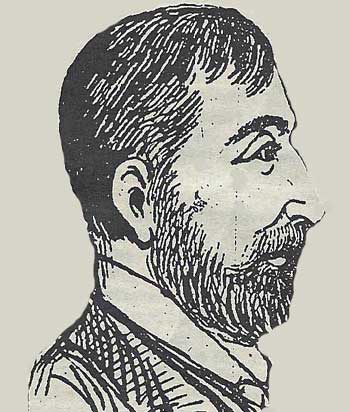
Edmund Reid
1888
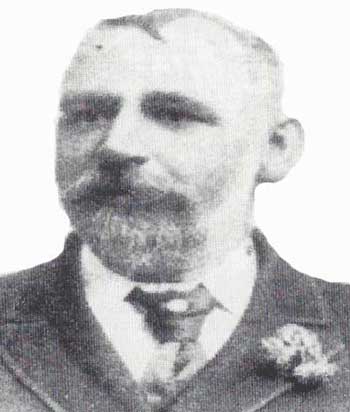
Edmund Reid
1896
THE MURDER OF EMMA SMITH
The Whitechapel murders to which Reid referred in his interview, took place between April, 1888 and February, 1891, and included the five murders that are now considered to have been at the hands of Jack the Ripper.
The first murder was that of Emma Smith, which took place in early April, 1888.
The police were, in fact, unaware of the murder of Emma Smith until, on 6th April, 1888, H Division was informed by the Coroner's Office that an inquest into her death was to held the following day.
Inspector Edmund Reid had to make speedy enquiries into her death, and the attack which led to it, in order to bring his Division up to speed on the known facts in time for the inquest, and he duly compiled a brief report giving details of what he had been able to uncover about the crime, which wasn't a great deal.
He had, he wrote, quizzed the police constables who would have been in the vicinity of the attack around the time that it would have taken place, but none of them could recall having seen or heard anything.
Reid made specific mention of the fact that Emma Smith would, most certainly, have passed several constables as she made her way back to her lodgings in George Street, Spitalfields, and then later, as she was escorted to the London Hospital by her fellow lodgers; yet none of the policemen in the area had neither been informed of the incident nor asked to render assistance.
THE MURDER OF MARTHA TABRAM
Following the murder of Martha Tabram, on 7th August, 1888, Reid was the officer in charge of the hunt for her killer. It was he who had the frustrating task of carrying out the identity parades at the Tower of London and the Wellington barracks in order to try to get "Pearly Poll" to identify the soldiers that she and Martha Tabram had been with on the morning of Martha's murder in George Yard.
THE OTHER MURDERS
Although the murder of Mary Nichols took place in the jurisdiction of "J" Division, Reid would certainly have been privy to the enquiries that the detectives of that division were making.
He was most certainly active in the investigation into the murders of Annie Chapman, Elizabeth Stride, Mary Kelly and Alice McKenzie.
THE MURDER OF FRANCES COLES
Reid headed up a large force of detectives in the wake of the murder of Frances Coles, which took place on Friday, 13th of February, 1891.
In its issue of Saturday, 14th February, 1891, The Evening Standard reported on some of the measures Reid was taking in his attempts to hunt down the perpetrator of the crime:-
Detective Inspector Edmund Reid, in charge of a large force of police, made on Friday a house-to-house search of the district, with no result.
The common lodging-houses, which abound in the district, coffee-shops, hotels, etc., were all searched, but nothing suspicious was discovered.
Mr. Reid will visit the London hospitals, in order to discover when the deceased had the old wound on her head attended to and what name she went under.
The officer has made the following statement:- "In my opinion the crime has been done by the same hand that has perpetrated the other murders. We have as yet no definite clue, but hope soon to lay our hands on the fiend. I was immediately informed of the discovery, and proceeded to the spot, taking care that all approaches were blocked. The passage is well known to the police as a resort of bad women..."
RETIREMENT OF DETECTIVE INSPECTOR REID
Edmund Reid retired from the Metropolitan Police in February, 1896, and something of the esteem he was held in by so many people is reflected in the following article, which appeared in Lloyd's Weekly London Newspaper, on Sunday, 8th March, 1896.
Edmund Reid, who has been for some years Chief Detective-inspector for the district of Whitechapel, has retired from the service.
"Teddy Reid," originally steward on the Husbands' boat running to and from Margate, joined the police force, in the P division, on the 4th November, 1872.
He distinguished himself almost immediately after he entered the service, and in 1874 was appointed a detective.
In 1873 be was made a serjeant, in 1880 raised to the second-class, and in 1881 to the first-class.
Up to 1884 Reid was engaged chiefly in the district of Walworth and Camberwell.
That year he was removed to Scotland-yard.
Thence, in 1885, he was sent to Bethnal-green, where he formed the first detective staff stationed in the neighbourhood, and was thus the organiser of the J division.
In 1887 he was placed in charge of the difficult district of Whitechapel.
He was here during the trying period when the whole of the terrible Ripper murders were committed.
At the time of his retirement he was the oldest Detective-inspector in the service.
Reid holds the bronze and gold medals of the Balloon Association of Great Britain, the latter for having made the highest ascent on record in his day.
Indeed, Reid has sufficient medals for acts of bravery to cover his breast."
REID'S ENQUIRY AGENCY
Following his retirement, Edmund Reid tried his hand as a publican, and became the landlord of the Lower Red Lion pub in Herne, in Kent.
However, the allure of detective work appears to have proved too much for him, and, in October, 1898, he gave up the pub's licence, and set himself up as a freelance private enquiry agent working from premises at 9, Southampton Row, in Holborn in the West End of London.
In the early 1900's he was promoting his services in various newspapers, making use of the Weekly Despatch commendation that had hailed him as "one of the most remarkable men of the century".
An idea of the type of investigation he would have undertaken can be gleaned from the following two adverts from 1903 and 1904 respectively:-

From The Standard, 2nd December, 1903
Image copyright The British Library Board. All Rights Reserved

From The Morning Post, 17th February, 1904
Image copyright The British Library Board. All Rights Reserved
PERSONAL TRAGEDY
Despite advertising himself from premises in central London, Reid and his wife, Emily, had in fact, taken up permanent residence in their native Kent, and Reid, according to an interview he later gave to Lloyd's Weekly London Newspaper, considered himself to be a "man of Kent", stating that "...I would not be back in London for anything..."
However, in early 1900, Emily's mental state began to deteriorate alarmingly, and, on 30th April, 1900, she was admitted to a lunatic asylum in Kent.
Here, her deterioration, both physical and mental, continued unabated, and, on the morning of August, 14th, 1900, she died of chronic organic brain disease.
In the years following his wife's demise, Reid became an active campaigner on local issues, was a regular letter-writer to the newspapers, and was always willing to give an opinion on cases he had worked on, or even on cases that had occurred since his retirement, should a journalist ever approach him for a quote.
THE MURDER OF MARY ANNIE AUSTIN
However, he kept fully abreast of the criminal goings-on in his old dominion and was frequently quoted in the press throughout his twilight years.
On 26th May, 1901, the murder of Mary Annie Austin, took place. She had been brutally attacked at Crossingham's Lodging House, located at 35, Dorset Street, Spitalfields; and she later died of her injuries at the London Hospital.
Speculation was rife that her murder might well spell the return of the ripper, and the opinion of several detectives who had been active in the original hunt was sought by various newspapers.
One ex-detective who was happy to comment on the case was former Special Branch officer Patrick McIntyre, who explained the ten years gap between the murder of Frances Coles, on 13th February, 1891 and the murder of Annie Austin, with the suggestion that the Whitechapel Murderer may have been arrested for another offence shortly after he killed Frances Coles and had been sentenced to ten years in prison.
Having recently been released, McIntyre opined, the murderer had returned to his old haunts and recommenced his murder spree.
McIntyre suggested that the police should examine the antecedents of every released convict who had recently returned to the East End of London.
REID REMEMBERS
The other former detective who was happy to go on record was Edmund Reid, who wholeheartedly disagreed with McIntyre, and, in response, he put together a report for the Sun newspaper, which was republished by the East London Observer on Saturday, 1st June, 1901.
Reid was also anxious to dispel the rumours, then circulating, that Jack the Ripper was known to have been a maniac surgeon:-
...The "Sun," in a special article, discusses the Whitechapel murders as follows:-
"The 'Ripper' has been spoken of during the last few days as a maniac surgeon.
That he was a maniac the evidence goes to show. That he was a surgeon is contrary to the evidence.
[Retired police officer Edmund] Reid, who was an exceptionally well-instructed officer, says, under this heading in the report we drew up together:-
The Ripper was a man with no skilled knowledge - not even the skill of a novice in butchery.
In every instance the mutilation, clumsy in the extreme, was the hacking and tearing of a man in a frenzy, increasing in intensity as his work proceeded.
It was said in the case of the woman Kelly that portions of the body were carried away.
This was not true. Every body was found complete. It was simply hacked without any system or plan other than dictated by ferocity.
Another absurd theory was that the murders were the work of a left-handed man, who had seized his victim from behind.
The evidence was quite contrary to this. In the throat-cutting the fiend had shown cunning. The position of the blood and the body showed that he had stood face to face with the woman, and had slashed her throat with his right hand from right to left, causing the blood to spurt away from him, so that he probably never had any blood stains on his clothes.
One of the great difficulties of the case for the police was that it was a case of a maniac's cunning outwitting reason's methods.
Every murder was committed in a dark, secluded spot, generally on private property, as in the case of the woman Austin, now under investigation.
As no one ever saw the man, except his victims, not the slightest evidence could be obtained as to his description."
Ex-detective McIntyre, who was at Scotland Yard, and engaged from there on the Ripper inquiries, has a theory which, while not comforting, is certainly consistent with reason and practical experience.
McIntyre believes the Ripper is still alive, and that during the long periods which elapsed between one murder and another he was in prison for some minor offence.
Five years and ten years' penal servitude are the most common sentences for felony.
If the Ripper murderer were sent away for ten years for some offence shortly after the murder in Swallow Gardens [Frances Coles] in February, 1891, he would not be at liberty again. He would be certain to return to his old haunts, and if McIntyre were still in the detective service he would suggest a thorough inquiry into the history of every convict who has returned home to Spitalfields after being in prison during the time the Ripper murders have ceased.
Ex-Detective Reid, on the other hand, is of opinion that the man who committed the Ripper murders has long since been dead, a victim to the consuming frenzy for mutilation, a frenzy which must have long ago destroyed the man, body and soul."
HIS MEMORY AT FAULT
Reid's comments are, to say the least, interesting, since he was a highly placed detective at the time of the murders, and was, therefore, privy to much of the inside knowledge that the police possessed on the crimes and the potential perpetrators of the atrocities.
And yet, he shared a common fault that most of his colleagues suffered with when recollecting the case in their retirement, that is - he misremembered certain facts of the case.
The biggest mistake he made in his report to the Sun was the emphatic assertion that "Every body was found complete", and that no body parts had been taken away.
This, most certainly, was not the case, as both Annie Chapman and Catherine Eddowes had both had body parts removed and taken away, and Mary Kelly's heart was also missing from the scene of the crime.
A LETTER FROM EDMUND REID
As far as local issues were concerned, Reid's letters to the newspapers - and there were plenty of them - do make for intriguing reading as he appears to have been quite the eccentric, and you pick up something of his quirky sense of humour when reading his missives.
PROGRESSIVE WHITSTABLE
On Saturday, 14th July, 1906, for example, Reid, who was living on Borstal Hill at the time, wrote to the Whitstable and Herne Bay Herald to challenge a letter that had been sent in by another reader the previous week:-
To the editor
SIR
Why, whatever is the matter with the anonymous writer who signs himself "A Progressive" in your last week's issue touching the above subject.
Why don't he come and live up Borstal Hill way, where all is peace and joy?
We ain't got no troubles up our way like he writes about.
We ain't got no path to get out of order between "The Four Horse Shoes" Hotel and the end of Whitstable District.
We ain't got no gas lamp that wants lighting to shew us our way home on a dark night like they have at Tankerton.
We ain't got no scavengers coming and taking away our dust and putting it in a heap to annoy our visitors. We look after that ourselves.
We ain't got no trouble to read any acknowledgment to our applications for a gas lamp and a path to the end of Whitstable District (which we pay for), because they never send one.
Cheer up, old boy, better days in store.
Thanking you in anticipation for a good time coming, when we shall all know the boundary of Whitstable on the road to Canterbury by the erection of a gas lamp on a footpath.
Believe me to remain, Yours very faithfully.
EDMUND REID
Borstal Hill.
REID TAKEN TO COURT
In 1907, Reid found himself in the place he had put so many people during his professional career - court; albeit Reid's case was civil as opposed to criminal!
Again, something of Reid's personality shines through in the transcript of the proceedings, which was published by Whitstable and Herne Bay Herald, on Saturday, 13th April, 1907:-
HE WILL HAVE HIS POUND OF FLESH
THE STORY OF A BORSTAL HILL RESIDENCE.An action brought in the Canterbury County Court on Tuesday by George Hall, of Whitstable, against Edmund Reid, an ex-inspector of Scotland Yard of Hampton, for £5. 15 shillings for rent caused considerable amusement.
Mr. J. F. Whichoord, of Whitstable, who appeared for the plaintiff, told his Honour Judge Shortt that the claim was for rent of a house at Borstal Hill. The quarter's rent really amounted to £5. 10 shillings , but when quarter day came round the defendant was unable to pay, and offered to pay an extra pound a year if Mr. Hall would wait a little longer for his money.
The tenancy was held under a lease and the rent was paid regularly up to the 29th of September.
Plaintiff was now suing for the quarter's rent due to December 15th last.
It was an unfurnished house.
Plaintiff gave evidence bearing out his solicitor's statement, and said defendant had now been living in the house about two years, and had always paid his rent until this time.
Defendant said the house was not fit to live in, and he doubted whether the agreement for six years' tenancy was a legal one.
Mr. Whichoord said it was properly signed and stamped.
His Honour: "You have been living there for two years, and yet now you say it is not fit to live in. Supposing you can prove what you say, what is the good of that now?"
Defendant: "I sent him the key."
His Honour: "How, you have an agreement for six years?"
Defendant: "But is that a legal agreement or not?"
His Honour: "Whether it is or not it is no defence in this case. You are sued for a quarter's rent."
Defendant: "But the place is over-run with rats."
His Honour: "That is no defence in law."
Defendant: "And there is not a room that the rain does not come in."
His Honour: "That is no defence." (Laughter.)
Defendant: "He says this house cost him a £1,000 to build."
Plaintiff: "Quite right."
Defendant: "And yet it is over-run with rats."
Plaintiff: "You got it cheap enough at £22. If there are any rats it is through your own neglect."
His Honour: "All this is no defence in law. You have lived there two years and cannot raise such a defence now. Besides you have signed an agreement by which you are under an obligation to keep the place in repair. How does that tally?"
Defendant: "Then why has he paid for many of the repairs himself?"
His Honour: "That makes no difference. You have signed an agreement, and if the roof fell in I about your ears it would be no defence in law."
Defendant: "It has been down twice and he has put it up again. (Laughter.) I took it for six years and I must put up with it for another four years then."
Plaintiff: "I have got a tenant that would take it directly, but I won't release yon Mr. Reid. Oh no!"
Defendant: "It is a hornet's nest about my ears."
Plaintiff: "If you will compensate me I could let it to-morrow."
His Honour said he should not allow the 5s. interest, and made an order for the payment of £5 10s.by the end of May.
Mr. Whichoord said there would be another quarter's rent due by then.
Plaintiff: "And I will have him for it."
Defendant: "You will have your pound of flesh." (Laughter.)
Plaintiff: "Yes, I will."
His Honour advised defendant to take legal advice in the matter.
HELPING RECRUITS JOIN THE METROPOLITAN POLICE
However, thoughts of his old life appear to have still been much in his mind, and, throughout 1912, he was advertising his services, free of charge, to use his experience to assist any young men in Kent who wished to follow in his footsteps and seek a career in the Metropolitan Police.
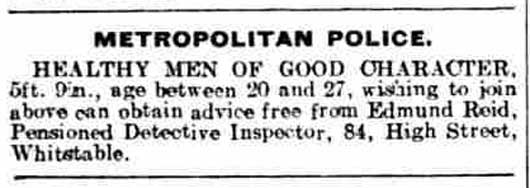
From the Whitstable Times and Herne Bay Herald, 14th December, 1912
Image copyright The British Library Board. All Rights Reserved
AN INTERVIEW WITH LLOYD'S WEEKLY NEWSPAPER
No doubt Reid was happy to talk any potential recruits through the potential pitfalls of life as a Metropolitan Police Officer, and, no doubt, many of them were curious to learn his opinion on the identity of the perpetrator of the most infamous series of crimes that Reid had worked on - the Jack the Ripper murders.
And the retired Reid was more than willing to hold forth on the crimes; and, unlike several of the officers he had worked with, he was only too willing to admit that, despite the police's best efforts, Jack the Ripper had, quite simply, eluded them.
On February 4th, 1912, Lloyd's Weekly London Newspaper published the following interview with Reid, in which he expounded on his personal opinion about the case:-
It is not often that one hears of an officer of the famous Criminal Investigation Department of Scotland Yard, voluntarily exchanging the excitement of his professional duties for a quiet country life.
But, there are some who do, and among them is ex-Inspector Edmund Reid, who was associated with some sensational cases.
A representative of Lloyd's Weekly News recently found Mr. Reid at the little seaside resort of Hampton-on-Sea, near Herne Bay.
"I would not be back in London for anything," Mr. Reid declares, with emphasis.
Although he was taken to London when in long clothes, he likes to call himself "a Man of Kent," for he was born at Canterbury, over Pickford's office, in Beer Cart-lane."
NO EVIDENCE AGAINST JACK THE RIPPER
Inevitably, the conversation in the course of the interview turned towards the most infamous series of crimes that Reid had been tasked with solving during his career - the Jack the Ripper atrocities.
Reid began by giving his view on statements that had been made by several people claiming that they knew the killer's identity, amongst them his old boss Sir Robert Anderson.
I have been asked to tell the story of the "Ripper" series many times, but to do so would necessitate the devotion of weeks of labour to the matter.
But this I will say at once. I challenge anyone to produce a tittle of evidence of any kind against anyone.
The earth has been raked over, and the seas have been swept, to find this criminal "Jack the Ripper," always without success.
It still amuses me to read the writings of such men as Dr. Anderson, Dr. Forbes Winslow, Major Arthur Griffiths, and many others, all holding different theories, but all of them wrong.
I have answered many of them in print, and would only add here that I was on the scene and ought to know."
A NEW THEORY ON THE RIPPER MURDERS
Having dismissed claims that anyone knew the identity of the ripper, Reid went on to announce his own personal theory on the case, as well as stating his certainty that the perpetrator of the crimes was someone who actually lived in the district:-
...Here are the only known facts. The whole of the murders were done after the public-houses were closed; the victims were all of the same class, the lowest of the low, and living within a quarter of a mile of each other; all were murdered within half a mile area; all were killed in the same manner.
That is all we know for certain.
My opinion is that the perpetrator of the crimes was a man who was in the habit of using a certain public-house, and of remaining there until closing time.
Leaving with the rest of the customers, with what soldiers call "a touch of delirium triangle," he would leave with one of the women.
My belief is that he would in some dark corner attack her with the knife and cut her up. Having satisfied his maniacal blood-lust he would go away home, and the next day know nothing about it.
One thing is to my mind quite certain, and that is that he lived in the district."
THE POLICE DID EVERYTHING
Reid then went on to defend his old comrades - and, of course, himself - for not having brought the murderer to justice:-
The police, of course, did everything possible with a view to the arrest of the man.
A set of rules was laid down as to the sending for assistance immediately upon any discovery, not only to Scotland Yard, but also to everyone who was likely to be required or of assistance.
And there was always a sort of interesting speculation as to who would reach the scene of a new crime first.
Inspector Abbeline and Inspector Moore, with a whole staff of detective officers from other divisions, and from the Yard, were sent to render every possible assistance, and there were vigilance societies formed, the members of which used to black their faces, and turn their coats inside out, and adopt all sorts of fantastic disguises before they turned out.
To one of the officers of this organisation the late Queen Victoria sent a letter of commendation, and the public subscribed very liberally.
Officially and otherwise many thousands of pounds were spent in the effort to catch "Jack," but he eluded us all."
HIS FINAL YEARS
In 1912 and 1913, Reid began delighting readers of the Whitstable Times and Herne Bay Herald, with a series of whimsical articles that recounted his experiences as a balloonist
In May, 1917, Reid remarried, his new wife, Lydia Rhoda Halling, being twenty years his junior.
The marriage would last a little over eight months.
Then, on the evening of Monday, 3rd December, 1917, Reid was taken suddenly ill.
He lingered for just over a day, and then, at 6.15am, on Wednesday, December 5th, 1917, he died.
Even in death, however, he was mainly remembered for his association with the Whitechapel murders, as is evidenced by the following brief report of his demise, which appeared in The Scotsman, on Friday, 7th December, 1917:-
Mr. Edmund Reid, who was Chief Detective Inspector of the Metropolitan Police district of Whitechapel during the period of the Ripper murders, died at Herne Bay on Wednesday, aged 71."
Article Sources
Register of Leavers From The Metropolitan Police. Ref: MEPO 4/340/157. It should be noted that his name in the Register of Leavers is given as Edwin John James Reid.
The Morning Post, Saturday, October 20th, 1877.
Lloyd's Weekly London Newspaper, Sunday, 16th June, 1878.
The Canterbury Journal and Farmers' Gazette, Saturday, 2nd May, 1896.
The Evening Standard, 2nd December, 1903.
The Morning Post, 17th February, 1904.
Whitstable and Herne Bay Herald, Saturday, 14th July, 1906.
Whitstable and Herne Bay Herald, Saturday, 13th April, 1907.
Lloyd's Weekly London Newspaper, Sunday, 4th February, 1912.
The Scotsman, Friday, 7th December, 1917
Nicholas Connell and Stewart P, Evans. The Man Who Hunted Jack the Ripper Rupert Books (1999).
Paul Begg, Martin Fido and Keith Skinner. The Jack the Ripper A to Z. Headline Book Publishing Plc (1992).

